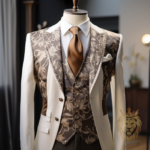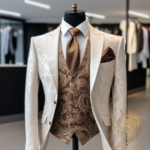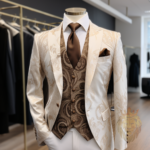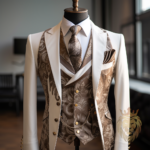In the world of business, first impressions are invaluable. Whether you’re sealing a deal, presenting a pitch, or leading a meeting, how you dress can significantly influence perceptions and outcomes. The modern gentleman knows that business attire is not just about dressing up; it’s about embodying professionalism, confidence, and personal style. Here’s your comprehensive guide to mastering business attire, ensuring you look polished and poised for every business occasion.
Understanding Business Attire
Business attire generally falls into two categories: business formal and business casual. The distinction is crucial, as it sets the tone for the level of professionalism expected in various settings.
- Business Formal: This is the highest standard of business attire, often required for high-stake meetings, formal events, and industries like finance and law. It typically includes a dark suit, dress shirt, conservative tie, dress shoes, and possibly a vest.
- Business Casual: A step down in formality, business casual allows for more personal expression while maintaining professionalism. Think slacks, collared shirts, and blazers or sports coats. Ties are optional, and there’s more room for color and pattern.
Selecting the Right Suit
The cornerstone of business attire is the suit. Here are tips for choosing the right one:
- Fit is King: A well-fitted suit makes all the difference. It should hug your shoulders, allow for comfortable movement, and the pants should fall just right. Tailoring is worth the investment.
- Fabric Matters: Wool suits are versatile and breathable, making them suitable for all seasons. For warmer months, consider lighter fabrics like linen or cotton.
- Color and Pattern: Stick to classic colors like navy, grey, and black for business formal. Business casual allows for more experimentation with colors and patterns, but it’s best to keep it understated.
Dress Shirts and Ties
Your shirt and tie can add personality to your suit without sacrificing professionalism.
- Shirt Selection: Opt for light-colored shirts in white, light blue, or pastel shades. Ensure the shirt fits well at the neck and sleeves.
- Tie Guidelines: The tie should complement your suit and shirt. For formal settings, choose silk ties in solid colors or subtle patterns. Ensure the tie’s width matches the lapel of your suit jacket.
Shoes and Accessories
The right accessories can elevate your business attire from good to great.
- Shoes: Invest in quality leather dress shoes. Oxfords and brogues are classic choices. Ensure they’re well-polished and in good condition.
- Watch: A sleek, simple watch can add a touch of sophistication. It’s both functional and a statement of style.
- Briefcase or Bag: Choose a high-quality leather bag or briefcase that matches the color of your shoes.
Final Tips
- Grooming is essential. Your attire is only part of the equation. Ensure you’re well-groomed, with neat hair and a clean shave or neatly trimmed beard.
- Mind the details: Pay attention to the small things—belt should match your shoes, socks should be long enough to cover your legs when sitting, and you should avoid flashy jewelry.
- Comfort and Confidence: Above all, ensure your attire is comfortable and boosts your confidence. You should feel powerful and poised, ready to tackle any business challenge.
Conclusion
Mastering business attire is about blending tradition with personal style, ensuring you’re dressed appropriately for the occasion while still expressing your individuality. By focusing on fit, fabric, and the fine details, you can curate a business wardrobe that empowers you to present your best self in the professional world. Remember, in business, your attire speaks volumes before you even say a word. Dress wisely, and let your style open doors to new opportunities.







































